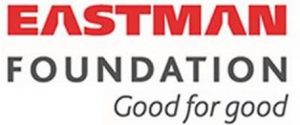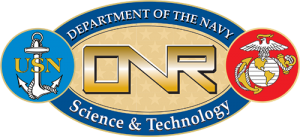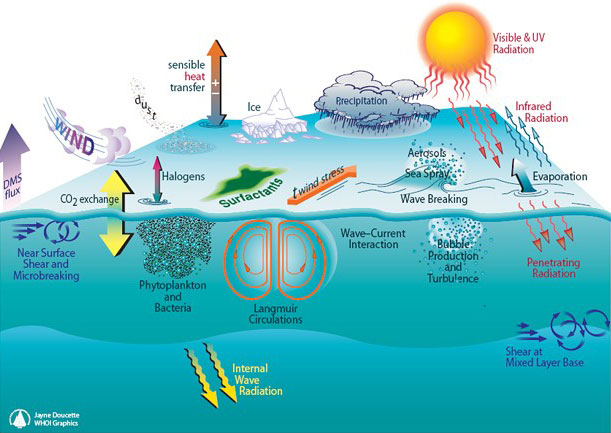What is air-sea interaction?
Air-sea interaction describes the dynamic, thermodynamic, and biogeochemical processes that link the atmosphere and oceans. The ocean stores incoming energy from the sun and then transfers heat and moisture to the atmosphere that fuels its circulation. These atmospheric circulations result in our weather systems that include mid-latitude storms and hurricanes. Once in motion, the atmosphere drives additional ocean circulation through the exchange of momentum across the air-sea interface that drives waves and currents.
Air-sea interaction also regulates the storage and release of anthropogenic and naturally occurring greenhouse gases, the generation of aerosols and cloud condensation nuclei from both sea-salt and phytoplankton-derived dimethyl sulfide. All of these processes fundamentally depend on the exchange of momentum, heat and mass across marine boundary layer.
Why do we need a Center to focus on air-sea interaction?
A significant area of uncertainty in weather and climate science is our limited understanding of near-surface ocean processes and their interactions with the atmosphere, land, and ice systems. Direct observations of the exchanges between the ocean and atmosphere are rarely made as they are difficult and costly. And yet, these air-sea exchanges are sensitive indicators of changes in the climate system, with links to floods and droughts, storm intensity and storm tracks, as well as the carbon cycle. Variability in these exchanges drives climate variations, such as the El Niño/Southern Oscillation, that have extensive impacts on regional and global economies, populations, infrastructure, food supply and political stability. Evaporation from the ocean is a major driver of changes in regional rainfall patterns that affect both agriculture and storm tracks. Heating through the ocean surface combined with changes in wind-driven ocean circulations affect regional sea level variability and long-term sea level rise. The near-surface ocean and atmosphere conditions governed by these air-sea interactions in the coastal regions affect renewable energy systems (e.g. near and offshore wind turbines), mitigation strategies, and the sustainability of our coastlines.
Given the importance of the problem, it is astonishing that only a handful of the research centers located at institutions or universities across the globe study the dynamics of the ocean and/or atmosphere focus on the actual interactions occurring at the interface between these two systems. Of those that do, there is expertise on only some aspects, such as data analysis or modeling. Several other universities have small groups of researchers (often just one or two) with interests in one or two aspects of air-sea interaction. To make significant advancements in our measurements, connect these measurement advances to improved models of air-sea interaction, and use these models to reduce the uncertainties in our weather and climate forecasts, a coordinated group of scientists and engineers is required.
Why is WHOI the place to establish this?
At WHOI, we have world-class observationalists, cutting-edge engineers, data synthesizers, satellite remote sensing experts, and high-resolution and climate modelers. Focusing the efforts of these experts on the air-sea interface and its impact on extreme events, seasonal weather patterns, climate-scale variability, as well as the water and biogeochemical cycles via a center would produce innovations in observations and modeling that would improve our understanding and predictive capability of the coupled ocean-atmosphere system. We have a significant base of researchers already interested in scientific and technological breakthroughs across the physical, biogeochemical, and engineering groups.
What is unique about CASIMAS?
Public-private partnerships
We have been working with the private sector for a number of years to better understand how businesses rely on weather and climate information. These researchers have been instrumental in developing new pathways for mutually beneficial partnerships that encourage the transfer of scientific and technological advances between both entities and leverages each partner’s individual strengths to make substantial contributions. We envision CASIMAS to be a model for these partnerships.
Personnel
WHOI already has a group of world-class interdisciplinary scientists working across physics, biology, chemistry, engineering, and marine policy. In this group are experts in observing through in situ or remote sensors and modeling of the air-sea interface. A Center would act to promote, organize and assist ongoing and new research and education initiatives across the departmental structure. Of particular interest for CASIMAS will be to engage and grow WHOI’s unique group of air-sea interaction scientists across the physical, biogeochemical, atmospheric, and engineering areas to work on societally relevant problems associated with climate change, sustainability, and energy.
Collaboration between science and engineering, technology and materials
Vital components of this research can only be accomplished through enhanced collaboration with WHOI engineers to take better advantage of WHOI’s world-class staff and its unique engineering and marine facilities.
Education
A goal of CASIMAS will be to train the next generation of scientists who can work across the interface using observations and numerical models. Stronger ties with industry partners will enable the development of innovative programs that will provide both scientists and students with knowledge and skills that can extend beyond science into technology that can drive innovations.
We have received support from the Eastman Foundation for the development of CASIMAS at WHOI by committing $500,000 over the next five years. These funds will be used to provide seed money for the development of innovative enhanced observational equipment; to educate the next generation of air-sea scientists and engineers through graduate student or post-doctoral support; and to provide support for early-career scientists and engineers to develop and test innovative ideas that will lead to more traditional funding pathways.


